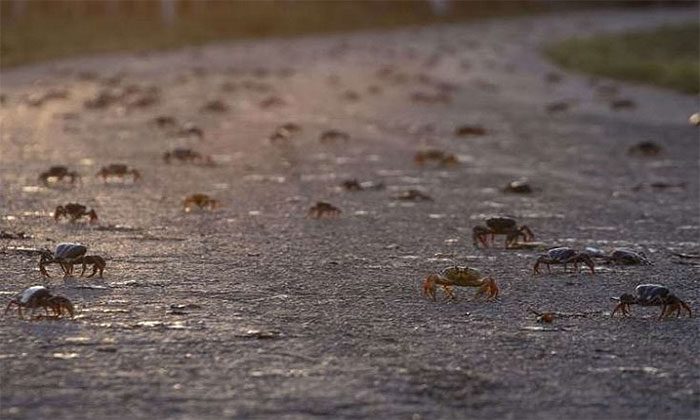Every year, millions of crabs emerge from the jungles in early spring and make their way towards Pigs Bay, crossing dangerous streets and highways to reproduce.
Red crabs migrating in Cuba. (Video: CTV News)
The migration journey of red crabs belonging to two species, Gecarcinus ruricola and Gecarcinus lateralis, raises concerns for drivers in the town of Giron, who must maneuver to avoid killing them. The crabs have become a nuisance for local residents, but the sight of them crossing the road is a wonder for tourists and passersby witnessing it for the first time.
“The crabs arrive here before we do,” shared Amaury Urra, a 50-year-old mountain guide who has lived his whole life in the largest Caribbean swamp, Ciénega de Zapata. “We are used to this.”
The town of Giron is located 180 km southeast of the capital Havana. This year, the crabs began their migration early. By the end of March, local authorities warned drivers to avoid traveling in the morning and evening, the preferred times for the crabs to move. Environmental activists have also called for the closure of main roads, especially during migration periods.
The journey of the red crabs can last until July, with the largest number of crabs spilling onto the roads in mid-April and May. Local residents need to be cautious during this time, as red crabs can puncture tires with their pincers when they feel threatened.

This year, the crabs started migrating early.
Official figures estimate that about 3.5 million crabs die each migration season, many of which are run over by vehicles. Red crabs also inhabit and migrate in the Bahamas, Nicaragua, Jamaica, and Dominica. However, in Giron and another coastal area near Cienfuegos province, their migration path sees a high volume of traffic.
The crab migration occurs after a two-year pandemic, leading to an unprecedented number of crabs. “We have observed an unusually high density of migration,” shared Reinaldo Santana Aguilar, a scientist at the Cuban Ministry of Environment, with Reuters. “It is likely that the crab population has recovered, which is why they are migrating in such large numbers.”
Over 4 million years ago, Gecarcoidea, the ancestors of these crabs, lived in the sea. However, they evolved slowly to survive in the shady forest floor. Like marine crabs, red land crabs still breathe using gills. To keep their gills moist, they dig burrows. During the spring rains, male and female crabs take the opportunity to find mates and breed.
Cuba is not the only island invaded by crabs. A similar land crab species also swarms the Christmas Island in the Indian Ocean every autumn. It is estimated that around 100 million red crabs crawl to the shore to reproduce there. Male crabs emerge first and take several weeks to reach the water’s edge, fighting for the best territories. Females follow, mate with the males, and carry their eggs for several weeks.
In Cuba, the eggs hatch upon contact with seawater, and the juvenile crabs begin their journey back to the forest after some time. On both islands, authorities are making efforts to protect the crabs by closing off certain roads and sidewalks to allow the crabs to cross.


















































